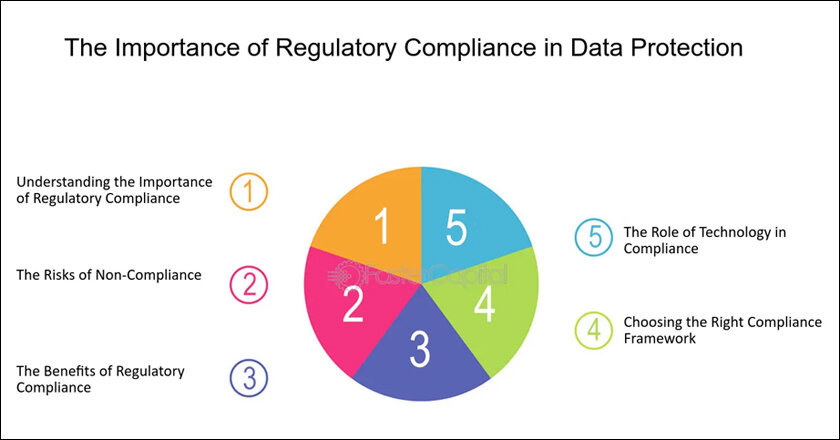Data protection and compliance with regulations are paramount for organizations handling sensitive information. However, navigating the complex and diverse regulatory frameworks can be a daunting task.
The protection of data is of utmost importance for any organization. With an increasing number of cyber threats and data breaches, organizations must navigate complex regulatory landscapes to ensure compliance and protect sensitive information. This blog post will delve into the importance of data protection and compliance, discussing the challenges organizations face and offering insights on how to navigate these intricate regulatory landscapes.

Understanding Data Protection
Data protection refers to the practices and measures put in place to safeguard sensitive information from unauthorized access, use, or disclosure. This includes personal data, such as names, addresses, and social security numbers, as well as business data, including financial records, intellectual property, and trade secrets. Data protection is crucial for maintaining trust and privacy in the digital world, both at an individual and organizational level.
The Role of Compliance in Data Protection
Compliance, on the other hand, refers to the adherence to rules, regulations, and industry standards set by governing bodies or regulatory authorities. It is essential for organizations to comply with these regulations to demonstrate their commitment to data protection and ensure the security of the data they handle. Compliance requirements vary by industry and country, making it even more challenging for organizations to navigate.

Challenges in Navigating Regulatory Landscapes
Navigating regulatory landscapes can be a daunting task for organizations, primarily due to the following challenges:
1. Diverse Regulatory Frameworks: Different countries and industries have varying data protection regulations and compliance requirements. For organizations operating internationally or across different sectors, understanding and aligning with these diverse frameworks can be complex and time-consuming.
2. Evolving Regulatory Landscape: Regulatory frameworks are not static and are constantly evolving to address new threats and challenges. Staying updated with the latest regulatory changes and ensuring compliance is an ongoing task for organizations.
3. Lack of Resources and Expertise: Many organizations, especially small and medium-sized enterprises, may lack the necessary resources or expertise to navigate complex regulatory landscapes. This can make it difficult to comply with data protection regulations effectively.

Navigating the Complex Regulatory Landscapes
While navigating complex regulatory landscapes can be challenging, organizations can take several steps to ensure compliance and data protection. Here are some key considerations:
1. Conduct a Data Audit: Start by taking stock of the data you collect, store, and process. A comprehensive data audit will help you identify any gaps in data protection and highlight areas that need improvement.
2. Stay Updated with Regulations: Regularly monitor industry news, subscribe to regulatory updates, and engage with industry associations to stay informed about the latest regulations. This will help you anticipate changes and ensure compliance.
3. Develop Robust Policies and Procedures: Establish clear policies and procedures that outline how data should be handled and protected within your organization. This includes guidelines on data retention, access controls, encryption, and incident response.
4. Educate and Train Employees: The significance of data protection and compliance should be communicated to all employees. Training programs should focus on raising awareness about potential risks, best practices for data handling, and the importance of reporting data breaches promptly.
5. Implement Data Protection Technologies: Invest in data protection technologies such as encryption, access controls, and data loss prevention tools. These technologies can help mitigate risks and ensure compliance with data protection regulations.
6. Regularly Conduct Security Audits: Regular security audits are essential to identify vulnerabilities and weaknesses in your systems and processes. These audits will provide insights into areas that need improvement and help you stay on top of compliance.

Final Thoughts
Data protection and compliance are critical components of any organization’s strategy. Navigating complex regulatory landscapes can be a challenging task, but with the right approach, organizations can ensure compliance and protect sensitive information from unauthorized access.
By conducting data audits, staying updated with regulations, developing robust policies and procedures, educating employees, implementing data protection technologies, and conducting regular security audits, organizations can navigate these intricate regulatory landscapes effectively. Prioritizing data protection and compliance will not only safeguard sensitive information but also enhance trust with customers and stakeholders, setting the stage for long-term success.
In case you missed:
- Understanding Data Residency
- Data Classification and Risk Assessment: Foundations for Effective Data Protection
- Data Management Techniques
- Top 5 Cloud Security Threats and How to Combat Them
- Common Data Protection Mistakes Businesses Must Avoid
- Balancing the Scales: AI Evolution vs Ethics
- Safeguarding Remote Workforce: Data Protection Measures
- The Rise of Data Fabrics: Unleashing the Power of Enterprise Data
- All about Ransomware
- How to Implement Multi-Factor Authentication for Enhanced Security?









